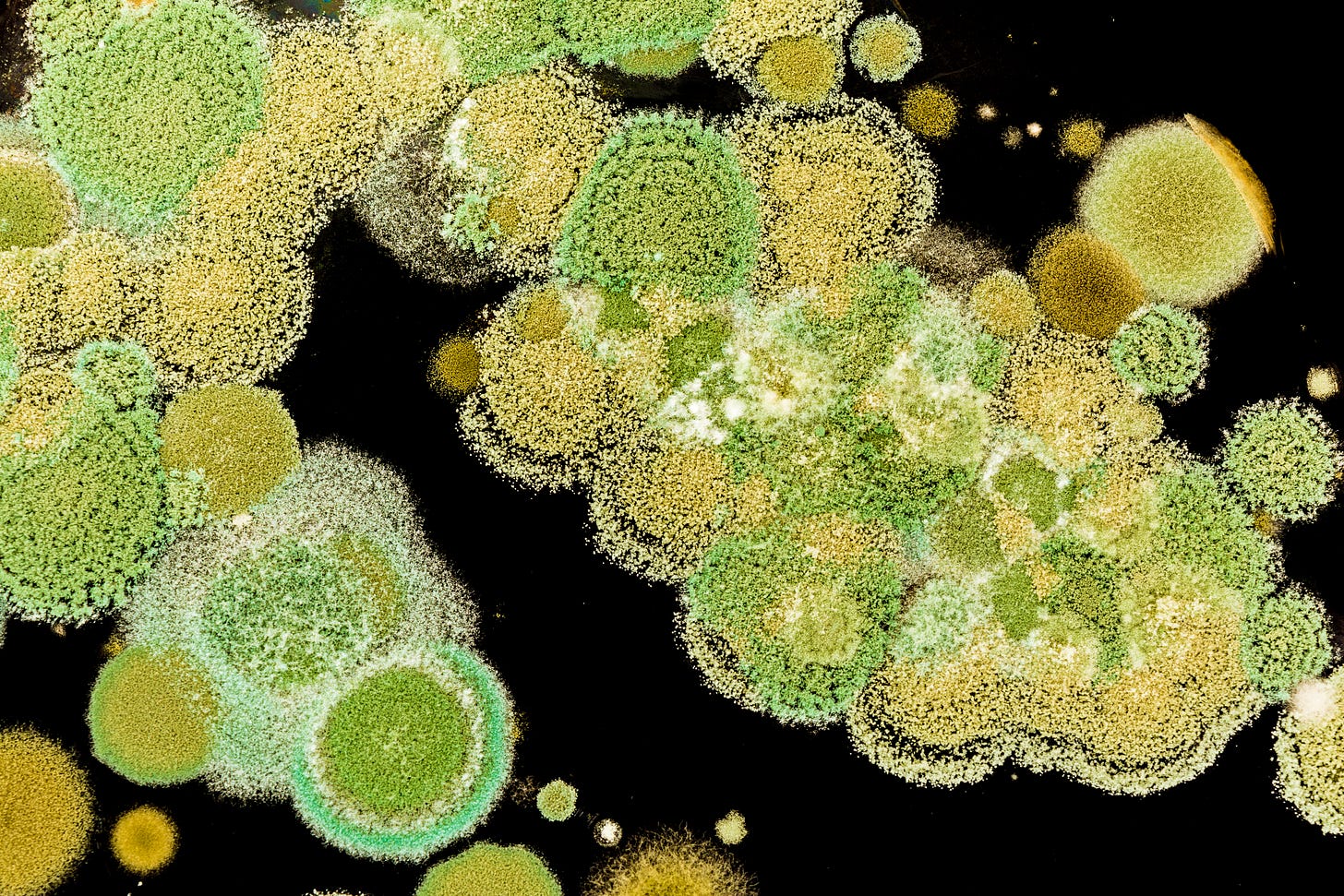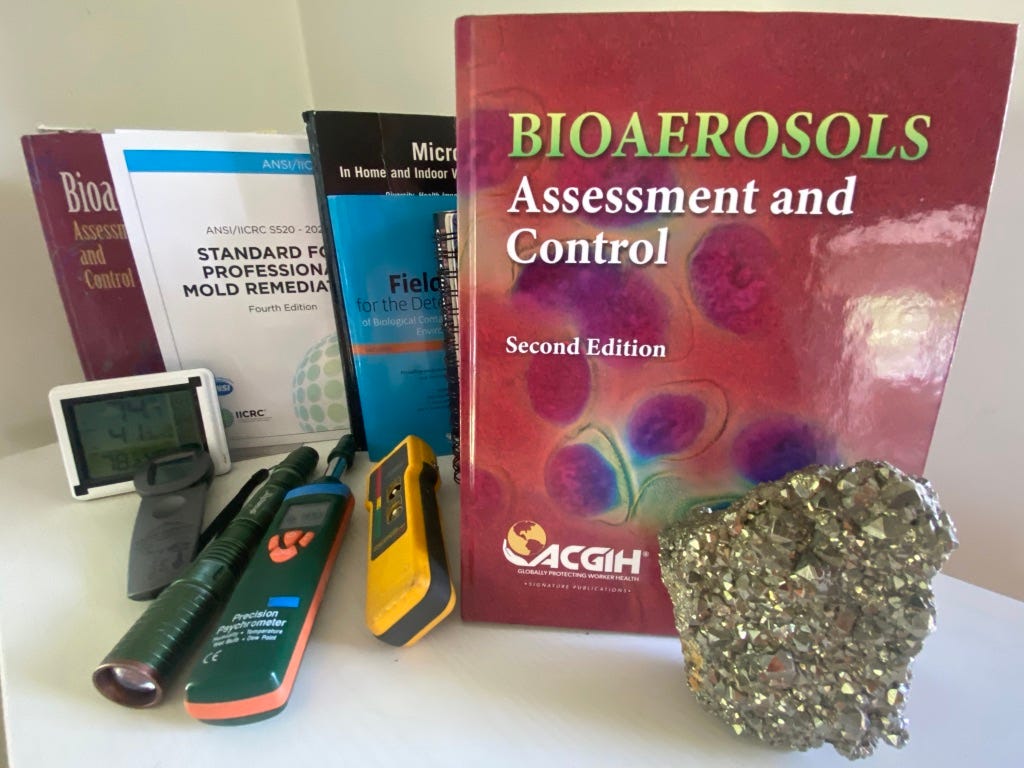by J. Scott Armour, M.S., OEHS Consulting & Testing Professional
June 15, 2024
I’ve recently noticed an remarkable, and unsettling increase in clients asking me about the “test” that said they “had mold”.
Near the end of this blog article I have provided an excerpt from the most referenced text in our industry that explains, very briefly and to-the-point, that settling plates should not be used.
Settling Plates
Settling Plates are used to collect mold spore; they are also called a “petri dish”, which has layer of a sticky substance called agar that nourishes microorganisms like bacteria and molds. After you pay someone $35 or $40 dollars for one of these plates, you place it somewhere in the home, wait a few hours or days, hope some mold spores fall on it, send the dish to a lab and they culture it - they grow it. They report to you how many colonies of mold grew - usually called a CFU or colony forming unit.
The lab will also tell you the name of the mold - but only the genus, not the species. So you are told “Aspergillus/Penicillium”, not Aspergillus niger or Penicillium roqueforti. The lab might even tell you it’s “toxic” mold. Scary, right?
Not so. Settling plates are not a reliable collection method - this means they have poor accuracy.
That’s right - the result from the lab about the settling plate is NOT accurate.
The most important reason it is not accurate is because settling plates are not actually collecting a representative amount or type of mold spores. Most mold spores in your home won’t even come near the settling plate. This means, you do not know what’s really in the air in your home. This means, if you make a decision about what to do with the air or your home or your family, you will be using BAD DATA to make that decision.
The lab report is actually real “fake news”.
USELESS. A WASTE of MONEY.
You are given a report and asked to believe it and told to act on it - but there is just not much truth to it. In fact, so little truth, so little accuracy, that you shouldn’t even be using this test in the first place!
BAD DATA
Mold colonies on a culture plate.
The unsettling promotion of settling plates
This test is being promoted by LABS because they make money. A lot of money! For some reason the labs forget to tell you that this method is not very reliable. For some reason, the labs are giving you advice about a result that can’t be trusted. For some…. oh just never mind, they’re making money! What do they care?
This test is promoted by the people that diagnose mold illness too - like “mold literate” doctors, naturopaths, functional medicine practitioners (who are not really M.D'.’s - ask them!) , and health coaches because it makes them look good. After all, they are “the doctor”!
And in many cases, they are making money too. Your decision to “get treatment”, or “come back in three months for another check-up”, or “buy their special supplements” makes them money.
Your decision to “hire someone to fine particle clean your home”, or “rip out your walls and remediate” - makes someone money too. These are very real decisions that impact your life in very serious ways.
Recommending this test is wrong because the science behind the sampling method says so. Settling plate tests do not answer the questions people people are asking, which are typically, “Is this house contaminated with mold?”, or “Are the occupants exposed to mold?”. Using settling plates, paying a lab a ton of money, trusting someone treating an illness, is unfortunate.
Unfortunate.
There are no serious credible environmental health professionals who use these. That alone should tell you something important. That alone should make you think twice before you buy these things.
Sampling Methodology Knowledge is Required
But WHY else are the docs recommending them?
They just don’t know.
Because they are not educated about sampling methodology or characterizing the indoor environment or assessing occupant exposure. AND because “someone told them they work”, or “the lab promoted and advertised they work”. Ask your practitioner who tells you to take these tests WHERE they learned about them! Ask them if they know about the reliability and validity issues. Ask them if they know a real OEHS professional who uses and recommends them. If they can’t answer - and they won’t - then maybe you should reconsider your practitioner’s advice.
WHY does a laboratory recommend them? Same reasons.
They just don’t know.
The Reference
There is an indisputable, and indispensable, reference that explains why NO ONE should use Settling Plates to assess mold in a home - or any building.
The Bioaerosols reference book from ACGHI.
The Gold Standard
The new revision of the seminal work, “Bioaerosols”, released earlier this year (2024), is considered the OEHS Industry’s “gold standard” of the science of bioaerosols and their impact on health. It is both basic and advanced. It is not for the light-hearted! Any environmental health science, OEHS, Industrial Hygiene, or public health professional who relies on science must have and understand this book.
I expect that the typical “IEP” or “mold tester” that comes to your house does not even know it exists - much less use it as a reference to support their work.
I also expect that the assessor and inspection and mold finding companies (and there are a bunch of them now) that take 45, 50, 65 samples and charge $8000.00, $10,000, and even more for one visit do NOT use this as a reference either. Even the ones that are “certified”, or have cool looking Insta posts, or an informative YouTuber, or are “recommended” by naturopaths, do not use this book as a reference.
How do I know?
If they used Bioaerosols as a reference, they would NEVER take that many samples and have to charge you that much money to look for water damage and mold growth.
Even if they do not take settling plates, the Bioaerosols explains what these people, these companies, these “influencers” are doing wrong that is costing you money and causing you undo fear and heartache.
Science. It’s required.
“Bioaerosols”, known as the “Red Book”, encompasses the required science for the OEHS professional who takes samples to characterize indoor environments and assess exposure - including water damaged buildings, schools, homes, and mold contaminated spaces. If your professional or consultant doesn’t rely on this document and understand it, as the basis of almost all their work, you should reconsider who you have hired.
If you have a lab, IEP, remediator, naturopath, medical practitioner, blogger, or big box hardware store that is selling you settling plates, or instructing you to take this type of test, STOP right there. Do not buy them. Do not use them.
Setting Plates are NOT an acceptable method.
These companies and individuals are taking your money, wasting your time, and might be making you worry and fear for NO reason. They are simply giving you BAD and USELESS data. Demand a refund!
If you do not believe this, or have questions about the science and methodology of characterizing a hazard, contamination, or any object or data, in any environment, please feel free to contact me, Scott Armour via direct message, text, tag, or email. I’ll be happy to answer and help you out.
Here is the definitive, and short, explanation from BIOAEROSOLS: Assessment and Control, 2nd Edition, ACGIH, 2024, pp.134-135.
Section 7.5 Principles of Particle Collection (including mold spores)
7.5.1 Gravitation or settling
The gravitational settling of particles (i.e., mold spores) onto a culture plate or a microscope slide is dependent on particle size and strongly influenced by air movement. As a result, mostly larger particles settle down onto the collection surface, resulting in misrepresentation of the percentage and type of airborne microorganisms present due to exclusion of smaller particles.* Gravity sampling is non-quantitative and investigators cannot directly correlate the number of CFUs on a settling plate or the number of spores on a gravity slide to the airborne concentrations of the corresponding particles in the sampled environment over a given period. Gravity samples are not suitable substitutes for volumetric air samples and should not be used, even to determine the relative air concentrations of different microorganisms, because of the method's collection bias.





What about swabs that are then placed on the plate?
Hi, Scott. I am interested in consulting with you, however, when I click the link on your site to do so, I am met with a message stating "The page you were looking for couldn't be found." How do I contact you for a possible consultation?